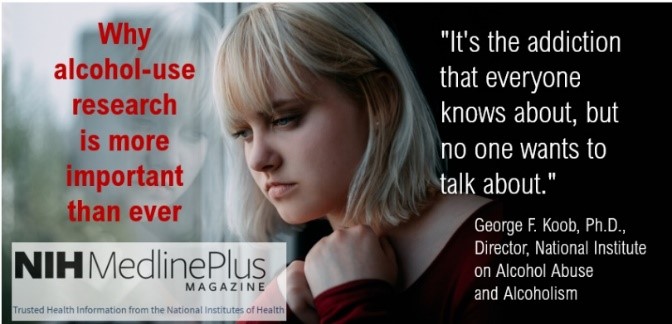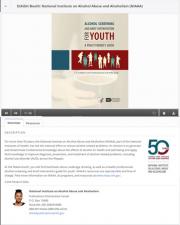NIAAA Director's Report on Institute Activities to the 155th Meeting of the National Advisory Council on Alcohol Abuse and Alcoholism
Virtual Meeting
Table of Contents
- NIAAA BUDGET
- DIRECTOR'S ACTIVITIES
- NIAAA COMMITMENT TO REDRESSING INEQUITITES IN THE RESEARCH COMMUNITY
- NIAAA COVID-19 RESPONSE
- STAFF TRANSITIONS
- RECENTLY ISSUED NOTICE OF FUNDING OPPORTUNITIES
- NOTABLE NIAAA STAFF ACTIVITIES
- WHAT'S AHEAD?
- NIH RESEARCH HIGHLIGHTS
- NIAAA COMMUNICATIONS ACTIVITIES
Fiscal Year (FY) 2020
In FY 2020, the National Institutes of Health (NIH) received a total of $41.6 billion, $2.3 billion above the fiscal year 2019 enacted level. NIH also received $836 million in supplemental funds to respond to the coronavirus pandemic (H.R.6074 – Coronavirus Preparedness and Response Supplemental Appropriations Act, 2020, Pub. L. 116-123) enacted March 6, 2020. On March 27, 2020, President Trump signed the Coronavirus Aid, Relief, and Economic Security (CARES) Act, Pub. L. 116-136, into law, which provided NIH with an additional $945.5M for vaccine, therapeutic, and diagnostic research.
NIAAA is currently closing out FY 2020. The FY 2020 appropriation for NIAAA provided $545.4 million. This represents a $19.8 million (3.8 percent) increase over the FY 2019 budget level. NIAAA estimates it will support a total of 739 research project grants (RPGs) in FY 2020.
FY 2021
The FY 2021 budget is under development.
NIAAA Director Dr. George F. Koob accepted, on behalf of NIAAA, the 40 millionth copy of the A.A. Big Book at the Alcoholics Anonymous International Convention – A Virtual Experience on May 26, 2020.
Dr. Koob gave the following presentations between May 1, 2020, and July 31, 2020:
- “NIAAA: State of the Science” for the American Society of Clinical Psychopharmacology Annual Meeting Virtual Conference Plenary Session on May 29, 2020
- “NIAAA: State of the Science” for the College on the Problems of Drug Dependence Scientific Meeting – Virtual Experience Plenary Session on June 22, 2020
- “NIAAA Update and 50th Anniversary highlights” for the Research Society on Alcoholism Annual Scientific Meeting Virtual Closing Ceremony on June 24, 2020
- “NIAAA Updates” for the Friends of NIAAA virtual meeting on June 30, 2020
NIAAA COMMITMENT TO REDRESSING INEQUITIES IN THE RESEARCH COMMUNITY
Dr. Koob posted a statement on inequities in the research community and in America on the Director’s Blog in June 2020.
At NIAAA, we recognize that diverse research teams broaden the scope of scientific inquiry, bring creative solutions to bear on complex scientific problems, and encourage research relevant to the health care needs of underserved populations. NIAAA is committed to diversifying the scientific workforce by promoting training, funding opportunities, and success for African Americans and other minorities facing disparities in funding rates and/or opportunities to pursue a successful research career. Our commitment extends to our intramural and extramural research programs and spans the pipeline from early education to established scientists. We are also committed to significantly expanding health disparities research so that all members of society may benefit from the work that we fund.
Impact of COVID-19 Pandemic on Alcohol Use and Treatment
- Physical distancing can lead to social isolation or loss of social support, which can lead to stress. Stress and uncertainty associated with the pandemic may prompt more people to drink alcohol to cope. For those in recovery, stress related to the pandemic could precipitate relapse.
- Physical distancing poses challenges for treatment and recovery. Face-to-face therapy and in-person mutual support group meetings may not be possible, but telehealth and virtual meetings can be helpful options for individuals seeking treatment or in recovery from AUD.
Impact of Alcohol Use on COVID-19 Pandemic
- The biological effects of alcohol could also exacerbate the pandemic. Alcohol compromises immune function, increasing the risk and severity of lung infections. Chronic alcohol consumption increases the risk for acute respiratory distress syndrome (ARDS), with increased need for mechanical ventilation, prolonged intensive care unit stay, and higher incidence of mortality.
- Alcohol is also known to produce behavioral disinhibition and can promote risky behavior with both friends and strangers.
NIAAA staff are contributing to numerous NIH-wide COVID-19 activities:
NIH Intramural Targeted Anti-COVID-19 (ITAC) program. This program, funded by the National Institute of Allergy and Infectious Diseases (NIAID), supports COVID-19 research activities for intramural investigators in NIH ICs outside of NIAID. Drs. Vijay Ramchandani and Nancy Diazgranados were awarded funding for their project “COVID-19 Pandemic Impact on Alcohol (PIA) – A Natural History Study.”
Accelerating COVID-19 Therapeutic Interventions and Vaccines (ACTIV) Initiative. This public-private partnership was launched in April to develop a coordinated research strategy for prioritizing and speeding development of the most promising treatments and vaccines.
NIH Rapid Acceleration of Diagnostics (RADx) Programs
Underrepresented Populations (RADx-UP). This initiative aims to lay the foundation to reduce disparities for underserved and vulnerable populations who are disproportionately affected by the COVID-19 pandemic.
Radical (RADx-rad). This program supports new, non-traditional approaches to address current gaps in COVID-19 testing.
NIH COVID-19 Candidate and Technologies Portal. This portal collects data on diagnostic, therapeutic, vaccine, and other candidates or technologies with near-term potential for testing against COVID-19, as well as other information that could be leveraged in the response to COVID-19.
Additional NIH-wide COVID-19 working groups with NIAAA participation:
Pregnant and Lactating Women and Children
Bringing NIH Clinical Trial Networks Together
Preclinical Therapeutic Discovery
Social, Behavioral, and Economic Health Impacts of COVID-19
New Staff

Ms. Jayme Gemmell joined the Administrative Services Branch as the Intramural Section Chief. Jayme worked at the National Institute of Allergy and Infectious Diseases (NIAID) for the past eight years, most recently as the Deputy Operations Administrative Manager within the Intramural program.

Dr. Jeremy Luk joined the Office of the Clinical Director as a licensed clinical psychologist with research expertise in alcohol and drug use, mental health, suicide, and health disparities. He obtained his Ph.D. in clinical psychology from the University of Washington in 2015, and subsequently received postdoctoral training at the University of California San Diego (2015–2016) and at the Eunice Kennedy Shriver National Institute of Child Health and Human Development (2016–2018).

Dr. Laura Manella joined the Communications and Public Liaison Branch as a science writer/editor. Laura earned a Ph.D. in neurobiology from Cornell University, where she studied the effects of stress on rodent sensory memories. Following a postdoctoral teaching fellowship (2015–2017), she served as an American Association for the Advancement of Science (AAAS) Science and Technology Policy Fellow (2017–2019) in the science communication and policy offices at the National Institute on Deafness and Other Communication Disorders (NIDCD). She then worked as a contractor for IQ Solutions, largely continuing her work at NIDCD.

Ms. Angela Szwec, LATG, was appointed Animal Care and Use Committee (ACUC) Administrator in the Office of Laboratory Science within the Division of Intramural Clinical and Biological Research. Angela received her M.S. in Biomedical and Veterinary Sciences in 2006 from Virginia-Maryland Regional College of Veterinary Medicine. Angela is a Certified Professional in IACUC Administration (CPIA, 2019) and has 13 years of laboratory animal research experience supporting the intramural research program at the National Institutes of Health.

Ms. Michele-Vera Yonga, RN, joined the Laboratory of Neuroimaging within the Division of Intramural Clinical and Biological Research as an Advanced Practice Nurse (Nurse Practitioner). After earning her B.S. in Nursing from the University of Texas at Arlington in 2015, Ms. Yonga earned her M.S. in Nursing from the University of South Alabama and her Post Masters Certificate as a Family Nurse Practitioner from the American Academy of Nurse Practitioners National Certification Board in 2018. She has previous experience in rehabilitation medicine and in family and urgent care.
Departing Staff
Dr. Joseph Hibbeln, Captain of the Commissioned Corps of the U.S. Public Health Service (USPHS), retired from government service in June 2020 after 28 years at NIAAA. During his career at the Institute, he received international recognition for initiating the study of the role of omega-3 fats in depressive and impulsive disorders. His research portfolio as Acting Chief of the Section on Nutritional Neuroscience of the Laboratory of Membrane Biochemistry and Biophysics covered epidemiological studies on nutritional intake of omega-3 fatty acids, clinical studies on metabolism of nutritional fats, and treatment studies of how establishment of a healthy balance of nutritional fatty acids might benefit mental health conditions. Dr. Hibbeln authored more than 175 peer-reviewed scientific publications. Noteworthy are his contributions to “Advice about Eating Fish for Women Who Are or Might Become Pregnant, Breastfeeding Mothers, and Young Children”, part of the U.S. Dietary Guidelines for Americans. He has proudly worn the uniform of the USPHS Commissioned Corps and was deployed frequently to address urgent public health needs.
Dr. Soundar Regunathan, Division of Neuroscience and Behavior (DNB), retired from federal service in August 2020. Prior to joining NIAAA in 2009, Dr. Regunathan was co-discoverer of agmatine’s activity in the central nervous system and its involvement in pain transmission. At NIAAA, he developed robust research programs on alcohol and pain, alcohol and sleep, as well as research on sex differences in alcohol effects. Dr. Regunathan served on the NIH Helping to End Addiction Long-Term (HEAL) Preclinical Therapeutics Team and contributed to countless HEAL funding announcements and concept proposals. He served for many years on NIH’s NIH Sleep Research Coordinating Committee and promoted research on alcohol and sleep through funding opportunities and workshops both at NIAAA and in collaboration with other NIH ICOs. He was the program officer for the Neurobiology of Adolescent Drinking in Adulthood (NADIA) Consortium and contributed significantly to DNB’s research program on the effects of adolescent drinking on the brain. He also co-led NIAAA’s Biomarker Team and was recently recognized with an NIH Director’s Award for his contributions to stimulating central nervous system (CNS) biomarkers research as part of a trans-NIH Team.
Dr. Corinde Wiers, Research Fellow in the Laboratory of Neuroimaging within the Division of Intramural Clinical and Biological Research, has accepted a position at the University of Pennsylvania as a tenure-track Assistant Professor of Psychiatry and Radiology. Her research laboratory will primarily study the effects of metabolic ketosis on alcohol consumption and brain energetics in alcohol use disorder using positron emission tomography (PET) and magnetic resonance imaging (MRI).
RECENTLY ISSUED NOTICE OF FUNDING OPPORTUNITIES
Notice of Funding Opportunities (NOFOs) Issued by NIAAA:
Collaborative Partnership between Research Centers in Minority Institutions (RCMI) and Alcohol Research Centers (U54 - Clinical Trial Optional): This NOFO invites U54 applications for the implementation of partnership between RCMI and other institutions with extensive alcohol research programs, including NIAAA-funded alcohol research centers and consortia (ARC). This NOFO is designed to facilitate planning and implementation of collaborative partnerships between RCMI and ARC to enhance diversity in the biomedical workforce, with emphasis on alcohol-related research and activities. Through productive partnership with ARC, this NOFO aims to build and promote alcohol research expertise and to develop alcohol research infrastructure and capacity at RCMI. RFA-AA-20-010
Alcohol-HIV/AIDS Program Project Comorbidities, Coinfections, and Complications Research: Intervention and Cross-Cutting Foundational Research (P01 - Clinical Trial Optional): The NOFO solicits applications for human studies that will advance operations or implementation research in the context of alcohol and HIV/AIDS by facilitating the development of: 1) broader systems approaches for monitoring complex HIV and alcohol-related morbidity and mortality, and 2) interventions to reduce the impact of alcohol on HIV disease progression and transmission. RFA-AA-20-009
Emergency Awards: Automatic Detection and Tracing of SARS-CoV-2 (U01 - Clinical Trial Not Allowed): NIH issued this NOFO (with NIAAA as the lead IC) in response to the declared public health emergency issued by the Secretary, U.S. Department of Health and Human Services (HHS), for 2019 Novel Coronavirus (COVID-19). This emergency NOFO from NIH provides an expedited funding mechanism as part of the Rapid Acceleration of Diagnostics-Radical (RADx-rad) initiative. This request for applications (RFA) will support the early-stage development of an innovative platform that integrates biosensing with touchscreen or other digital devices to achieve detection and tracing of SARS-CoV-2 in real-time. Projects are expected to demonstrate proof-of-concept of SARS-CoV-2 detection with high sensitivity and specificity, sensor functionality, and automatic detection by touchscreen or other digital devices. RFA-OD-20-014
Notices of Special Interest (NOSIs) Issued by NIAAA:
Epidemiology and Prevention in Alcohol Research:This NOSI supports applications that advance knowledge about the epidemiology of alcohol use, which is fundamental to improving public health. One prominent objective is to better understand the developmental trajectories of alcohol use, risky drinking, and epigenetic changes in gene expression produced by interactions with environmental influences and alcohol use disorder (AUD). NOT-AA-20-017
Secondary Analyses of Existing Alcohol Research Data: The purpose of this NOSI is to solicit applications to support the secondary analyses of existing data sets with the goal of enhancing our understanding of the following: 1) the patterns and trajectories of alcohol consumption, 2) the epidemiology and etiology, including genetics, of alcohol-related problems and disorders, and 3) alcohol-related health services and health systems, including access, quality, and efficiency. NOT-AA-20-018
Alcohol and Aging: The purpose of this NOSI is to promote research to improve our understanding of the effects of alcohol consumption on aging across different levels of biological organization including the molecular, cellular, tissue, organ, organism, and societal levels. NOT-AA-20-019
NIH-wide COVID-19 Research NOFOs with NIAAA participation:
Emergency Awards RADx-rad: Novel Biosensing for Screening, Diagnosis and Monitoring of COVID-19 From Skin and The Oral Cavity (Fast-Track STTR - Clinical Trial Not Allowed) RFA-OD-20-021
Emergency Awards RADx-rad: Novel Biosensing for Screening, Diagnosis and Monitoring of COVID-19 From Skin and The Oral Cavity (R44 - Clinical Trial Not Allowed) RFA-OD-20-020
Emergency Awards: RADx-rad: Data Coordination Center (DCC) (U24 - Clinical Trial Not Allowed) RFA-OD-20-019
Emergency Awards RADx-rad: Screening for COVID-19 by Electronic-Nose Technology (SCENT) (U18 - Clinical Trial Not Allowed) RFA-OD-20-017
Emergency Awards: RADx-rad Multimodal COVID-19 surveillance methods for high risk clustered populations (R01 - Clinical Trial Optional) RFA-OD-20-016
Digital Healthcare Interventions to Address the Secondary Health Effects Related to Social, Behavioral, and Economic Impact of COVID-19 (R01 - Clinical Trial Optional) PAR-20-243
Community Interventions to Address the Consequences of the COVID-19 Pandemic among Health Disparity and Vulnerable Populations (R01 - Clinical Trial Optional) PAR-20-237
NIH-wide COVID-19 Research NOSIs with NIAAA participation:
Limited Competition for Emergency Competitive Revisions for Community-Engaged Research on COVID-19 Testing among Underserved and/or Vulnerable Populations NOT-OD-20-121
Emergency Competitive Revisions for Social, Ethical, and Behavioral Implications (SEBI) Research on COVID-19 Testing among Underserved and/or Vulnerable Populations NOT-OD-20-119
Competitive and Administrative Supplements for Community Interventions to Reduce the Impact of COVID-19 on Health Disparities and Other Vulnerable Populations NOT-MD-20-022
Emergency Competitive Revisions for Community-Engaged Research on COVID-19 Testing among Underserved and/or Vulnerable Populations NOT-OD-20-120
Digital Healthcare Interventions to Address the Secondary Health Effects Related to Social, Behavioral, and Economic Impact of COVID-19 NOT-MH-20-053
NIH-Wide NOFOs with NIAAA Participation:
BRAIN Initiative: Data Archives for the BRAIN Initiative (R24 - Clinical Trial Optional) RFA-MH-20-600
BRAIN Initiative: Theories, Models and Methods for Analysis of Complex Data from the Brain (R01 - Clinical Trial Not Allowed) RFA-EB-20-002
BRAIN Initiative: Tools for Germline Gene Editing in Marmosets (U01 - Clinical Trial Not Allowed) RFA-DA-21-006
BRAIN Initiative: Proof of Concept Development of Early Stage Next Generation Human Brain Imaging (R01 - Clinical Trial Not Allowed) RFA-EB-20-001
Mechanism for Time-Sensitive Drug Abuse Research (R21 - Clinical Trial Optional) PAR-19-064; see Notice of NIAAA participation NOT-AA-20-020
Device-Based Treatments for Substance Use Disorders (UG3/UH3 - Clinical Trial Optional) PAR-20-279
Promoting Research on Music and Health: Phased Innovation Award for Music Interventions (R61/R33 - Clinical Trial Optional) PAR-20-266
SBIR/STTR Commercialization Readiness Pilot (CRP) Program Technical Assistance and Late Stage Development (SB1 - Clinical Trial Not Allowed) PAR-20-128; PAR-20-129; PAR-20-130
Administrative Supplement for Research on Dietary Supplements (Administrative Supplement - Clinical Trial Not Allowed) PA-20-227
Research to Improve Native American Health (R21 - Clinical Trials Optional) PAR-20-214
Mid-Career Enhancement Awards to Integrate Basic Behavioral, Biomedical, and/or Social Scientific Processes (K18 - Basic Experimental Studies with Humans Required) PAR-20-226
NOTABLE NIAAA STAFF ACTIVITIES
Drs. Tatiana Balachova and Patricia Powell organized and led the virtual Executive Committee Meeting of the Interagency Coordinating Committee on Fetal Alcohol Spectrum Disorders (ICCFASD) on June 12, 2020.
Dr. Tatiana Balachova presented “Evidence for Prevention and How Has the COVID-19 Pandemic Affected the Needs, Treatment Availability, and Service Delivery” and “Evidence for FASD Prevention” at an international webinar on FASD Prevention, titled “COVID-19 and the Prevention of Fetal Alcohol Spectrum Disorders,” in July 2020.
Dr. Daniel Falk presented a talk titled “Treatment Outcomes in Pharmacotherapy Trials for Alcohol Use Disorder: Development of a New Endpoint using Reductions in World Health Organization (WHO) Drinking Risk Levels” at the American Psychological Association Virtual Convention in August 2020.
Dr. Ivana Grakalic organized and led a session titled “Comorbid AUD Anxiety & Depression” as part of the NIH Helping to End Addiction Long-Term (HEAL) Workshop “Managing Chronic Pain in Individuals with Co-occurring OUD, and Other Psychiatric Conditions” held virtually June 1–2, 2020. Dr. Grakalic and Drs. Laura Kwako and Mark Egli were part of the organizing team for the meeting.
Dr. Laura Kwako recorded two virtual presentations, “What Every Clinician Should Know About Alcohol” and “The NIAAA Alcohol Treatment Navigator: What It Can Do for You and Your Patients,” for the annual meeting of the American Psychiatric Association in June 2020.
Dr. Laura Kwako recorded a presentation, “Stigma and Alcohol: A Complex Problem,” as part of a trans-HHS panel on stigma for the American Psychological Association Virtual Convention held in August 2020.
Megan Ryan presented a webinar on small business research funding titled “Advancing Innovations in Research on Alcohol Use Disorder through Small Business Funding” on July 16, 2020. The event was widely attended and concluded with a moderated Q&A session where Ms. Ryan and Jeffrey Thurston fielded questions from potential small business applicants.
Dr. Joe Wang organized and chaired a session titled “Screening and Treatment for Alcohol Use Disorder in Patients with Alcohol-associated Liver Disease” for the 2020 Annual Meeting of the American Psychiatric Association held virtually in April. Dr. Kathy Jung gave a presentation within the session titled “How Well Can We Detect and Quantify Alcohol Use? A Review of Biomarkers and Biosensors.”
The NIAAA Jack Mendelson Honorary Lecture will take place as a virtual event on September 22, 2020, at 1:30 p.m. (EDT). This year's speaker is Dr. Sandra A. Brown, Distinguished Professor of Psychology and Psychiatry at the University of California San Diego. The title of her presentation is "Discerning Risks and Effects of Alcohol in the Midst of Adolescent Development.” The event can be viewed online: https://videocast.nih.gov/watch=38535
NIAAA will sponsor a virtual roundtable on the NIAAA Definition of Recovery on September 30, 2020, from noon to 3 p.m. (EDT). Drs. Brett Hagman and Daniel Falk will describe the development of NIAAA’s definition of recovery, followed by brief presentations by nine researchers who are experts in recovery. Drs. Hagman and Falk will then moderate a 45-minute discussion. Dr. Brett Hagman is the contact for this event.
NIAAA is sponsoring a virtual meeting, “Multi-Disciplinary Approach to Advance Care and Outcomes in Patients with Alcohol-Associated Liver Disease (ALD) and Alcohol Use Disorder (AUD),” on October 6, 2020, at 1:00 p.m. (EDT). This scientific meeting will bring together clinicians and researchers with experience in clinical trial design and implementation for ALD and medications development for treatment of AUD. The shared expertise can provide insights to improve clinical trial design and recruitment and retention of patients with AUD and/or ALD. Dr. Svetlana Radaeva is the contact for this event.
NIAAA will sponsor a webinar, “Substance Abuse Prevention for Youth in Indigenous Communities,” on October 8, 2020, at 1:00 p.m. (EDT). Dr. Judith Arroyo is the contact for this event.
Gestational Alcohol Exposure Disrupts Cognitive Function and Striatal Circuits in Adult Offspring
Significance: To identify molecular mechanisms underlying disrupted cognitive function related to prenatal alcohol exposure (PAE), this study examined the lasting effects of PAE on habitual and goal-directed behavior in adult mice. Compared to controls, mice exposed to alcohol during gestation were more likely to rely on cognitively demanding goal-directed decision making at the expense of more efficient, habit-guided decision making. These behavioral differences were linked to changes in GABAergic and endocannabinoid activity in the dorsolateral striatum, a brain region involved in learning and habit formation. These results demonstrate a mechanism for PAE-related cognitive deficits and identify a potential target for therapeutic intervention.
Fetal alcohol exposure (FAE) is the leading preventable developmental cause of cognitive dysfunction. Even in the absence of binge drinking, alcohol consumption during pregnancy can leave offspring deficient. However, the mechanisms underlying these deficiencies are unknown. Using a mouse model of gestational ethanol exposure (GEE), we show increased instrumental lever-pressing and disruption of efficient habitual actions in adults, indicative of disrupted cognitive function. In vivo electrophysiology reveals disrupted action encoding in dorsolateral striatum (DLS) associated with altered habit learning. GEE mice exhibit decreased GABAergic transmission onto DLS projection neurons, including inputs from parvalbumin interneurons, and increased endocannabinoid tone. Chemogenetic activation of DLS parvalbumin interneurons reduces the elevated lever pressing of GEE mice. Pharmacologically increasing endocannabinoid tone mimics GEE effects on cognition and synaptic transmission. These findings show GEE induces long-lasting deficits in cognitive function that may contribute to human FAE, and identify potential mechanisms for future therapeutic targeting. (Cuzon Carlson VC, Gremel CM, and Lovinger DM. Nat Commun. 2020 May 22;11(1):2555. doi: 10.1038/s41467-020-16385-4)
Circulating Extracellular Vesicles Carrying Sphingolipid Cargo for the Diagnosis and Dynamic Risk Profiling of Alcoholic Hepatitis
Significance: This study investigated the utility of plasma extracellular vesicle (EV) concentration and sphingolipid cargo as diagnostic and prognostic biomarkers for alcoholic hepatitis (AH), the most severe form of alcohol-associated liver disease. EVs isolated from plasma samples from healthy controls, heavy drinkers, and patients with other forms of liver disease were compared. EV counts were significantly higher in AH subjects than heavy drinkers without liver disease, MELD-matched patients with end-stage liver diseases not attributable to alcohol, and patients with alcoholic cirrhosis. The study also demonstrated that the EV counts predict 90-day survival for AH patients, permitting dynamic risk profiling.
Background & aims: Alcoholic hepatitis (AH) is diagnosed by clinical criteria, although several objective scores facilitate risk stratification. Extracellular vesicles (EVs) have emerged as novel biomarkers for many diseases and are also implicated in the pathogenesis of AH. Therefore, we investigated whether plasma EV concentration and sphingolipid cargo could serve as diagnostic biomarkers for AH and inform prognosis to permit dynamic risk profiling of AH subjects. Approach & results: EVs were isolated and quantified from plasma samples from healthy controls, heavy drinkers, and subjects with end-stage liver disease (ESLD) due to cholestatic liver diseases and non-alcoholic steatohepatitis, decompensated alcoholic cirrhosis (AC) and AH. Sphingolipids were quantified by tandem mass spectroscopy. The median plasma EV concentration was significantly higher in AH subjects (5.38X1011 /ml) compared to healthy controls (4.38X1010 /ml, p<0.0001), heavy drinkers (1.28X1011 /ml, p<0.0001), and ESLD (5.35X1010 /ml, p<0.0001) and decompensated AC (9.2X1010 /ml, p<0.0001) disease controls. Among AH subjects, EV concentration correlated with MELD score. When EV counts were dichotomized at the median, survival probability for AH subjects at 90 days was 63.0% in the high EV group and 90.0% in the low EV group (logrank p-value=0.015). Interestingly, EV sphingolipid cargo was significantly enriched in AH when compared with healthy controls, heavy drinkers, ESLD and decompensated AC (p=0.0001). Multiple sphingolipids demonstrated good diagnostic and prognostic performance as biomarkers for AH. Conclusions: Circulating EV concentration and sphingolipid cargo signature can be used in the diagnosis and differentiation of AH from heavy drinkers, decompensated alcoholic cirrhosis, and other etiologies of end-stage liver disease and predict 90-day survival permitting dynamic risk profiling. (Sehrawat TS, Arab JP, Liu M, Amrollahi P, Wan M, Fan J, Nakao Y, Pose E, Navarro-Corcuera A, Dasgupta D, Liao CY, He L, Mauer AS, Avitabile E, Ventura-Cots M, Bataller RA, Sanyal AJ, Chalasani NP, Heimbach JK, Watt KD, Gores GJ, Gines P, Kamath PS, Simonetto DA, Hu TY, Shah VH, and Malhi H. Hepatology. 2020 Apr 4. doi: 10.1002/hep.31256)
Microglia Control Escalation of Drinking in Alcohol-Dependent Mice: Genomic and Synaptic Drivers
Significance: This study investigated the role of microglia, the primary immune cells in the brain, in the development of alcohol dependence using a well-established mouse model of moderate and excessive drinking. Microglia depletion prevented neuroimmune-induced escalation in drinking, blocked the inflammatory response to alcohol, and decreased anxiety-like behavior during withdrawal. Further analyses demonstrated a link between microglia depletion and altered GABAergic and glutamatergic transmission in the central nucleus of the amygdala. This study suggests that microglia may regulate dependence-induced changes in neuronal function and have a role in the development and progression of alcohol use disorder.
Background: Microglia, the primary immune cells of the brain, are implicated in alcohol use disorder. However, it is not known if microglial activation contributes to the transition from alcohol use to alcohol use disorder or is a consequence of alcohol intake. Methods: We investigated the role of microglia in a mouse model of alcohol dependence using a colony stimulating factor 1 receptor inhibitor (PLX5622) to deplete microglia and a chronic intermittent ethanol vapor two-bottle choice drinking procedure. Additionally, we examined anxiety-like behavior during withdrawal. We then analyzed synaptic neuroadaptations in the central nucleus of the amygdala (CeA) and gene expression changes in the medial prefrontal cortex and CeA from the same animals used for behavioral studies. Results: PLX5622 prevented escalations in voluntary alcohol intake and decreased anxiety-like behavior associated with alcohol dependence. PLX5622 also reversed expression changes in inflammatory-related genes and glutamatergic and GABAergic (gamma-aminobutyric acidergic) genes in the medial prefrontal cortex and CeA. At the cellular level in these animals, microglia depletion reduced inhibitory GABAA and excitatory glutamate receptor-mediated synaptic transmission in the CeA, supporting the hypothesis that microglia regulate dependence-induced changes in neuronal function. Conclusions: Our multifaceted approach is the first to link microglia to the molecular, cellular, and behavioral changes associated with the development of alcohol dependence, suggesting that microglia may also be critical for the development and progression of alcohol use disorder. (Warden AS, Wolfe SA, Khom S, Varodayan FP, Patel RR, Steinman MQ, Bajo M, Montgomery SE, Vlkolinsky R, Nadav T, Polis I, Roberts AJ, Mayfield RD, Harris RA, and Roberto M. Biol Psychiatry. 2020 May 19:S0006-3223(20)31598-5. doi: 10.1016/j.biopsych.2020.05.011)
Not All Is Lost for Relapsers: Relapsers With Low WHO Risk Drinking Levels and Complete Abstainers Have Comparable Regional Gray Matter Volumes
Significance: Abstinence following treatment for alcohol use disorder (AUD) may not be readily achievable for all individuals. Accordingly, reductions in World Health Organization risk drinking levels (WHO-RDL) have received growing attention as alternative clinical trial endpoints. Following AUD treatment, cortical and subcortical brain region volumes were assessed among 3 groups of patients: a group who maintained abstinence and two groups who relapsed to drinking (sorted by low vs higher WHO-RDL). Results indicated that there are structural brain correlates (regional gray matter volumes) related to WHO-RDL, thus demonstrating biological and cognitive relevance of the measure. Brain regional volumes from MRI are objective assessments that may help inform evidence-based criteria for determining success in treatment or in clinical trials.
Background: Reductions in substance use are associated with positive long‐term treatment outcomes such as psychosocial functioning; substance use–related consequences; and mental, physical, and neurobiological health. Therefore, non abstinent clinical trial endpoints have received growing attention from substance abuse treatment experts. Regional brain tissue volumes in alcoholism treatment seekers increase during abstinence, in parallel to cognitive performance. Methods: We examined the relationships of drinking levels in those who did not maintain abstinence after treatment with magnetic resonance imaging‐derived gray matter (GM) volumes measured 8 months after baseline assessments while in outpatient treatment. The complex drinking behavior during the interval was operationalized as World Health Organization risk drinking levels (WHO‐RDL), derived from the number of standard alcoholic drinks per day. We compared the volumes of addiction‐relevant cortical and subcortical brain regions at long‐term follow‐up among abstainers and 2 groups of relapsers with low and higher WHO‐RDL. Results: We found that: (i) relapsers with low WHO‐RDL at follow‐up, who as a group had reduced their risk levels by 2.8 units (by consuming <40 g of ethanol per day over the recovery interval), had regional brain tissue volumes indistinguishable from those of abstainers tested after the same time period and that (ii) relapsers with higher WHO‐RDL, with only 1.2 units average risk‐level reductions, had significantly smaller frontal GM and thalamic volumes than abstainers and relapsers with low WHO‐RDL. Despite many drinking days during recovery, including several with >10 drinks per day, relapsers with low WHO‐RDL at follow‐up tended to perform better than those with higher WHO‐RDL on cognitive domains of working memory and visuospatial skills assessed over the recovery interval. Conclusions: Non abstinent recovery is characterized by addiction‐relevant GM volumes comparable to those of complete abstainers. The WHO‐RDL has meaningful structural neuroimaging correlates potentially suitable as cognitively relevant biomarkers of treatment response and general brain health, perhaps even as objective clinical trial endpoints. (Meyerhoff DJ and Durazzo TC. Alcohol Clin Exp Res. 2020; 44:1479-1487. doi: 10.1111/acer.14377)
Significance: Electronic health record data from a healthcare system that has integrated alcohol screening into routine primary care were analyzed to identify the associations between common medical conditions and different levels of alcohol use. Among nearly 900,000 patients who reported alcohol use, those with chronic obstructive pulmonary disease, chronic liver disease, or hypertension had higher odds for exceeding both daily and weekly alcohol guidelines associated with risk for alcohol use disorder. These results may aid primary care clinicians in specific disease management strategies targeted at particularly vulnerable patients.
Importance: Excessive alcohol consumption is associated with increased incidence of several medical conditions, but few nonveteran, population-based studies have assessed levels of alcohol use across medical conditions. Objective: To examine associations between medical conditions and alcohol consumption levels in a population-based sample of primary care patients using electronic health record data. Design, setting, and participants: This cross-sectional study used separate multinomial logistic regression models to estimate adjusted associations between 26 medical conditions and alcohol consumption levels in a sample of 2 720 231 adult primary care patients screened for unhealthy drinking between January 1, 2014, and December 31, 2017, then only among those reporting alcohol use. The study was conducted at Kaiser Permanente Northern California, a large, integrated health care delivery system that incorporated alcohol screening into its adult primary care workflow. Data were analyzed from June 29, 2018, to February 7, 2020. Main outcomes and measures: The main outcome was level of alcohol use, classified as no reported use, low-risk use, exceeding daily limits only, exceeding weekly limits only, or exceeding daily and weekly limits, per National Institute on Alcohol Abuse and Alcoholism guidelines. Other measures included sociodemographic, body mass index, smoking, inpatient and emergency department use, and a dichotomous indicator for the presence of 26 medical conditions in the year prior to the alcohol screening identified using International Classification of Diseases, Ninth Revision, Clinical Modification (ICD-9-CM) and ICD-10-CM diagnosis codes. Results: Among the 2 720 231 included patients, 1 439 361 (52.9%) were female, 1 308 659 (48.1%) were white, and 883 276 (32.5%) were aged 18 to 34 years. Patients with any of the conditions (except injury or poisoning) had lower odds of drinking at low-risk and unhealthy levels relative to no reported use compared with those without the condition. Among 861 427 patients reporting alcohol use, patients with diabetes (odds ratio [OR], 1.11; 95% CI, 1.08-1.15), hypertension (OR, 1.11; 95% CI, 1.09-1.13), chronic obstructive pulmonary disease (COPD; OR, 1.16; 95% CI, 1.10-1.22), or injury or poisoning (OR, 1.06; 95% CI, 1.04-1.07) had higher odds of exceeding daily limits only; those with atrial fibrillation (OR, 1.12; 95% CI, 1.06-1.18), cancer (OR, 1.06; 95% CI, 1.03-1.10), COPD (OR, 1.15; 95% CI, 1.09-1.20), or hypertension (OR, 1.37; 95% CI, 1.34-1.40) had higher odds of exceeding weekly limits only; and those with COPD (OR, 1.15; 95% CI, 1.07-1.23), chronic liver disease (OR, 1.42; 95% CI, 1.32-1.53), or hypertension (OR, 1.48; 95% CI, 1.44-1.52) had higher odds of exceeding both daily and weekly limits. Conclusions and relevance: Findings suggest that patients with certain medical conditions are more likely to have elevated levels of alcohol use. Health systems and clinicians may want to consider approaches to help targeted patient subgroups limit unhealthy alcohol use and reduce health risks. (Sterling SA, Palzes VA, Lu Y, Kline-Simon AH, Parthasarathy S, Ross T, Elson J, Weisner C, Maxim C, and Chi FW. JAMA Netw Open. 2020 May 1;3(5):e204687. doi: 10.1001/jamanetworkopen.2020.4687)
Healthcare Utilisation Prior to Suicide in Persons with Alcohol Use Disorder: National Cohort and Nested Case-Control Study
Significance: Alcohol use disorder (AUD) is one of the strongest reported risk factors for suicidal behavior. This study examined healthcare utilization patterns prior to suicide in persons with AUD in a large population-based cohort followed from 2002 to 2015. Of the people with AUD who died by suicide, 39.7% had a healthcare encounter within 2 weeks and 75.6% had a healthcare encounter within 3 months prior to death, compared with 6.3% and 25.4% of controls, respectively. These results indicate that healthcare encounters at primary care and specialty outpatient clinics offer critical opportunities to identify active suicidality and intervene accordingly in patients with AUD.
Background: Alcohol use disorder (AUD) is common and associated with increased risk of suicide. Aims: To examine healthcare utilisation prior to suicide in persons with AUD in a large population-based cohort, which may reveal opportunities for prevention. Method: A national cohort study was conducted of 6 947 191 adults in Sweden in 2002, including 256 647 (3.7%) with AUD, with follow-up for suicide through 2015. A nested case-control design examined healthcare utilisation among people with AUD who died by suicide and 10:1 age- and gender-matched controls. Results: In 86.7 million person-years of follow-up, 15 662 (0.2%) persons died by suicide, including 2601 (1.0%) with AUD. Unadjusted and adjusted relative risks for suicide associated with AUD were 8.15 (95% CI 7.86-8.46) and 2.22 (95% CI 2.11-2.34). Of the people with AUD who died by suicide, 39.7% and 75.6% had a healthcare encounter <2 weeks or <3 months before the index date respectively, compared with 6.3% and 25.4% of controls (adjusted prevalence ratio (PR) and difference (PD), <2 weeks: PR = 3.86, 95% CI 3.50-4.25, PD = 26.4, 95% CI 24.2-28.6; <3 months: PR = 2.03, 95% CI 1.94-2.12, PD = 34.9, 95% CI 32.6-37.1). AUD accounted for more healthcare encounters within 2 weeks of suicide among men than women (P = 0.01). Of last encounters, 48.1% were in primary care and 28.9% were in specialty out-patient clinics, mostly for non-psychiatric diagnoses. Conclusions: Suicide among persons with AUD is often shortly preceded by healthcare encounters in primary care or specialty out-patient clinics. Encounters in these settings are important opportunities to identify active suicidality and intervene accordingly in patients with AUD. (Crump C, Edwards AC, Kendler KS, Sundquist J, and Sundquist K. Br J Psychiatry. 2020 Jun 25:1-7. doi: 10.1192/bjp.2020.122)
NIAAA COMMUNICATIONS ACTIVITIES
Press and Publications Activities
Dr. Koob continues to speak with a variety of national and international news outlets on timely topics related to NIAAA’s research and its impact on treatment and prevention of alcohol misuse and AUD. Media attention continues to focus on the ongoing COVID-19 pandemic’s impact on alcohol use and the availability of alcohol treatment, as well as the effects of alcohol use on immune function. Interviews by Dr. Koob and other staff since May 2020 include Alcoholism & Drug Abuse Weekly, AARP, Deseret News, RadioMD, Livestrong, JUNTOS Center for Advancing Latino Health, and numerous other outlets.
NIAAA news items:
- Choline supplements in young children with fetal alcohol spectrum disorder have lasting cognitive benefits (July 20, 2020)
- COVID-19 means long stretch of stormy weather for people with alcohol and substance use disorders (July 14, 2020)
- Fetal alcohol spectrum disorders may increase the risk of type 2 diabetes and other metabolic issues (June 9, 2020)
- Drinking alcohol does not prevent or treat coronavirus infection and may impair immune function (May 12, 2020)
NIH news items:

- The National Library of Medicine’s NIH MedlinePlus Magazine featured Why alcohol-use research is more important than ever, published online on July 16, 2020. The Communications And Public Liaison Branch promoted this feature through social media and dissemination to liaison organizations.
- NIAAA resources and research are featured in the July 30, 2020 issue of Honoring Health: Resources for American Indians and Alaska Natives, a newsletter produced by the National Institute of Arthritis and Musculoskeletal and Skin Diseases on behalf of NIH, the Indian Health Service, and the HHS Administration for Community Living.
Additional news media coverage:
- EverydayHealth.com’s article, “Myths and Facts About Hangovers” included a link to NIAAA’s Hangovers factsheet.
- Livestrong.com interviewed Dr. Koob for its article, “How Bad Is It Really That You're Drinking More During Lockdown?”
- YaleMedicine.org included a link to the Alcohol Treatment Navigator in its article, “Drinking More Than Usual During the COVID-19 Pandemic?”
New and Updated Publications:
- Alcohol Treatment and Physical Distancing
[https://www.niaaa.nih.gov/publications/brochures-and-fact-sheets/alcohol-treatment-and-physical-distancing] - Risky Drinking Can Put a Chill on Your Summer Fun
[https://www.niaaa.nih.gov/publications/brochures-and-fact-sheets/risky-drinking-can-put-chill-on-your-summer-fun] - Fall Semester—A Time For Parents To Discuss the Risks of College Drinking
[https://www.niaaa.nih.gov/publications/brochures-and-fact-sheets/time-for-parents-discuss-risks-college-drinking]
NIAAA Exhibits Program Goes Virtual

The Institute supports up to 38 exhibits annually at professional meetings, community events, and education fairs. Due to the COVID-19 pandemic, NIAAA has shifted to virtual platforms for its exhibits program.
Social Media Highlights:
NIAAA Twitter: NIAAA’s Twitter account (@NIAAAnews) currently has more than 25,500 followers. Recent posts focused on COVID-19’s impact on people with substance use disorders, NIH’s RADx initiative, our updated summer factsheet, NIAAA’s 50th anniversary, and finding online treatment options.
Instagram: NIAAA’s Instagram account (@NIAAAnews) now has more than 1,200 followers. Recent posts include messages about alcohol treatment options during physical distancing, the NIAAA Alcohol Treatment Navigator, fetal alcohol spectrum disorders, seasonal messages, and research highlights.
Partnerships, Outreach, and Public Liaison Activities:
Urban One Radio: Throughout the summer, NIAAA aired a series of 30-second radio ads on Urban One network stations in Baltimore, Washington, D.C., and Philadelphia from July 14 to August 3. Topics included NIAAA’s Alcohol Treatment Navigator and Rethinking Drinking websites, alcohol overdoses, hangovers, blackouts, and telehealth resources during the COVID-19 pandemic.
Community Anti-Drug Coalitions of America (CADCA): On July 30, 2020, Dr. Ralph Hingson of NIAAA organized a session for the CADCA Mid-Year Training Institute that focused on policy and other interventions to address underage and young adult drinking and related alcohol problems.

